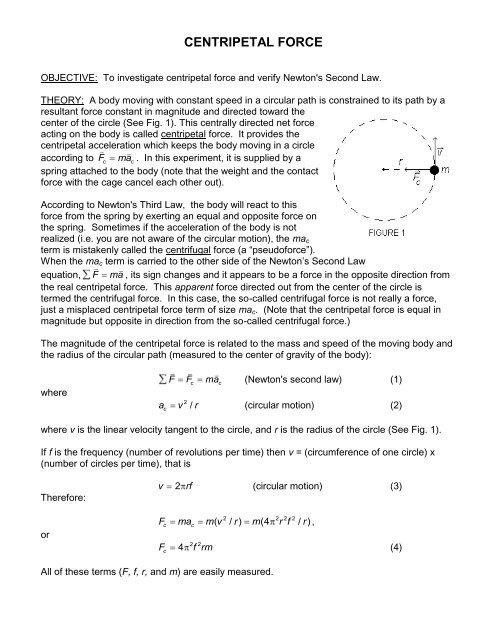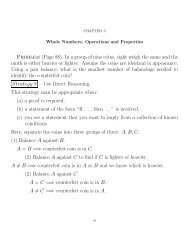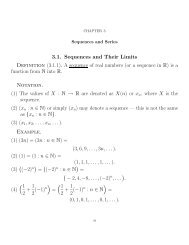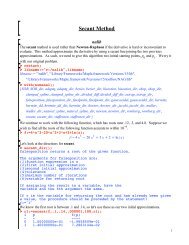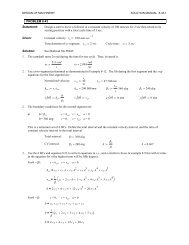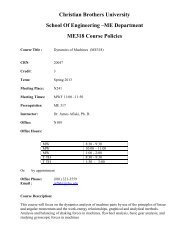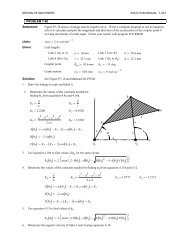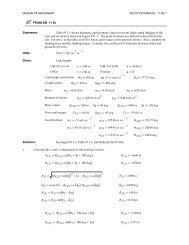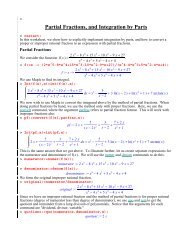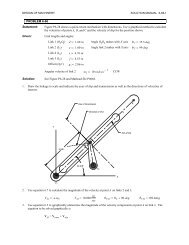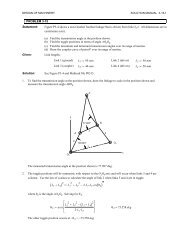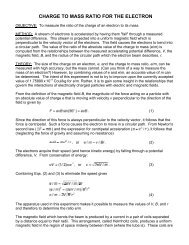CENTRIPETAL FORCE - CBU
CENTRIPETAL FORCE - CBU
CENTRIPETAL FORCE - CBU
Create successful ePaper yourself
Turn your PDF publications into a flip-book with our unique Google optimized e-Paper software.
Part 1. Testing Newton's Second Law:PROCEDURE 1:1) Attach the centripetal apparatus securely to the rotator.FCentripetal Force 2ma2) Tighten the holder with the key attached to the cord. Push the frequency button so that thedisplay reads the frequency in rev/min (rpm). Slowly increase the speed until the pointer goesabove the button. Slowly decrease the speed until the pointer goes below the button. Recordthe frequency for which the pointer is definitely high, for which it is definitely low, and then forwhich the pointer points right at the middle of the button. This will give the frequency as well asthe amount of possible uncertainty in the frequency measurement, f f.3) Record the mass of the moving body, m, that is stamped on the cylindrical body.4) Next remove the apparatus, and hang it by a piece of string from the stand. The springshould be near the top. Hang weights on it to stretch the spring until the pointer is againopposite the button. The tension in the spring is now the same as was exerted on the bodywhen it was rotating. The spring force now equals the weight of all the mass M attached to theend of the spring (F = Mg). Be sure to include in the value of M the mass of the rotating body,m. Estimate the uncertainty M in this value of M by seeing how much mass you can add andremove to make the pointer definitely move off the center of the button.5) While it is hanging, measure r from the center (white line) to the line on the body (whichmarks the center of gravity). Be sure to estimate the uncertainty r in this measurement.REPORT:1. Now we are in a position to check Newton's Second Law. Since we now know f, r, and m,we can calculate ma c . Do so.2. The tension in the spring (which is equal to Mg from 4) in the above procedure) provides thecentripetal force F c . Calculate the value of F c .3. Does F c = ma c ? Find the percent difference using the F c value as the standard.4. Consider your measurement uncertainties, and comment on whether they are sufficient toaccount for the percent error found in step 3 above. To do this, consider the percentuncertainty for each measurement: % uncertainty = ( /value)*100. When quantities aremultiplied, their percent uncertainties are added. Thus, when a quantity is squared (asfrequency is in the ma c calculation), its percent uncertainty is doubled.PROCEDURE 2:Now readjust the tension in the spring by turning the dial by the spring from the zero setting tothe 20 setting (or vise-versa), and repeat the experiment with the spring set at this new tension.After you have completed the Report section, answer the questions on the next two pages.
Centripetal Force 3Part 2. Questions About Circular MotionAnswer the following questions using the quantities obtained in Procedure 1. Answer incomplete sentences or equations, such as:W = m g = (value for mass) x (9.8 m/sec 2 ) = (value for weight).1. What is the weight (W) of the revolving body of mass (m)?2. When the mass (m) is being spun around, what is the centripetal force (F c ) on it (magnitudeand direction)?3. What causes the centripetal force, that is, what physical body or agent exerts the forcenecessary to keep the object moving in a circle?4. What causes the spring to be stretched? (HINT: consider Newton's Third Law)5. From the point of view of an observer riding on the revolving frame, however, this massbehaves exactly as if it were in an effective gravitational field with an acceleration due to gravity(g'). Recall that the revolving mass stretched the spring in our experiment exactly like a heavyweight did, and the mass would appear stationary (a = 0 m/s 2 ) to such a rotating observer.Therefore the observer would see the mass pulling “down” on the spring with a weight (W’) thatis equal in size but opposite in direction to the centripetal force that we observe in the laboratoryframe of reference:W'mg'Fmc a cFrom this point of view, what is the effective weight (W') of the revolving mass (magnitude anddirection)?6. What is the value of this g' (magnitude and direction)?7. Using the same radius as you used above, what frequency (f) expressed in rps and rpmwould the mechanism have to rotate at to make the effective weight equal to 100 times thestationary weight , i.e., W'=(100)W ?8. Suppose the spring broke while the mass was being rotated. Also assume that the massflies off and is not immediately stopped by the end of the rotating mechanism, and neglect theeffect of the real gravity in the room. What path would the mass appear to take as seen by anobserver in the room?9. What path would the mass in (8) above appear to take as seen by the observer located onthe revolving frame? At first, confine your analysis to the time immediately following the break.Then extend your analysis to later times.10. a) Draw a diagram showing the positions of the end of the rotating bar and the flying massas seen from the lab frame's point of view at the following five times:t 1 : the instant the mass starts to leave the end of the rotating bar,t 2 : the instant when the bar has rotated 90 from the release point,t 3 : the instant when the bar has rotated 180 from the release point,t 4 : the instant when the bar has rotated 270 from the release point,t 5 : the instant when the bar has rotated a full 360 from the release point.
Centripetal Force 4b) Draw a diagram showing the position of the mass relative to the end of the bar as seenfrom the point of view of an observer riding on the end of the rotating bar for each of the fivetimes in part (a) above.11. Finally, with your instructor, run the computer program on centripetal motion and compareyour sketches of the motion (question 10) with those generated by the computer, and see ifyour answers to question 10 are correct. If the computer is off, turn it and the monitor on. Loadthe Physics Menu. From the menu, type L to bring up the Lab menu and then enter 3 to runthe centripetal force routine.This idea of effective gravity is the principle that explains the operation of a “centrifuge”. Theterm "centrifugal force" is sometimes given to what we have called the effective gravity. Hencethe name centrifuge. Note that centrifugal force is not a real force and does not belong in the F term of F ma . However, to an observer on the rotating frame it appears thatcentrifugal force is real. Such an observer does not measure the same acceleration as thestationary observer measures and so must invent a force, the fictitious "centrifugal force", toaccount for the difference in acceleration.


